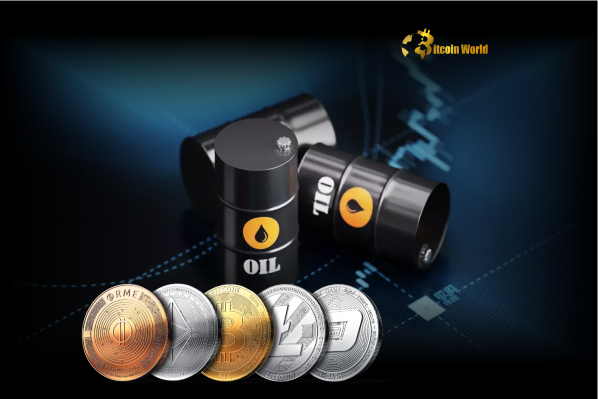BitcoinWorld

Shocking Oil Prices Surge Over 10%: Urgent Crypto Market Impact Revealed
Geopolitical tensions have once again sent shockwaves through global markets, with a dramatic surge in Oil prices taking center stage. For anyone tracking financial assets, including the dynamic world of cryptocurrency, understanding these shifts is paramount. This significant jump in energy costs isn’t just about the price at the pump; it has far-reaching implications that could directly influence the performance and perception of digital assets.
Why Did Oil Prices Skyrocket? Understanding the Trigger
The immediate catalyst for the sharp increase in Brent WTI futures was a specific geopolitical event. Reports of an Israeli airstrike in Iran triggered immediate concerns about potential supply disruptions in a critical oil-producing region. The Middle East remains a linchpin in global energy supply chains, and any instability there directly threatens the flow of oil, impacting prices globally.
Here’s a breakdown of the factors at play:
- Geopolitical Event: The specific incident involving Israel and Iran heightened fears of escalating conflict in a region vital for oil production and transit.
- Supply Concerns: Markets reacted swiftly to the possibility that conflict could disrupt oil production facilities or crucial shipping lanes like the Strait of Hormuz.
- Risk Premium: Traders immediately priced in a higher ‘risk premium’ due to the increased uncertainty and potential for future supply shocks.
- Market Psychology: Fear and speculation often amplify price movements in volatile situations, leading to rapid buying.
This event occurred within an already tense global environment, adding fuel to existing anxieties about energy security and supply-demand balances.
The Scale of the Surge: Brent and WTI Futures React
The reaction in the oil futures market was immediate and substantial. Both major benchmarks saw significant gains:
- Brent Crude Futures: The international benchmark surged by more than 10%.
- WTI Crude Futures: The U.S. benchmark also experienced a jump exceeding 10%.
A 10%+ move in a major commodity like oil within a short period is highly unusual and underscores the severity of the market’s reaction to the perceived increase in Geopolitical risk. This level of volatility hasn’t been seen frequently outside of major global crises.
Historically, oil prices have shown a strong correlation with geopolitical instability in the Middle East. Past conflicts and tensions in the region have often led to sharp, albeit sometimes temporary, price spikes as markets grapple with potential supply disruptions. This latest event fits a pattern of markets reacting nervously to regional flare-ups.
Economic Fallout: Inflation Fears Take Center Stage
One of the most significant consequences of rising Oil prices is their direct impact on inflation. Energy costs are a major component of consumer price indices (CPI) in most economies. When oil goes up, it directly increases the cost of transportation, manufacturing, and countless goods and services.
This surge intensifies existing Inflation fears around the globe. Central banks have been working to control inflation, and a spike in energy prices complicates this effort. Higher inflation can erode purchasing power, impact corporate earnings, and potentially lead to tighter monetary policies (like interest rate hikes) from central banks.
Potential economic consequences include:
- Higher Consumer Prices: Increased costs for fuel, heating, and goods manufactured using oil.
- Reduced Consumer Spending: As essential costs rise, discretionary spending may decrease.
- Increased Business Costs: Companies face higher expenses for logistics, production, and energy.
- Pressure on Central Banks: May force monetary authorities to maintain or implement stricter policies, potentially slowing economic growth.
- Supply Chain Issues: Higher transportation costs can exacerbate existing supply chain pressures.
The ripple effects of expensive oil are vast and can slow down economic activity, a phenomenon sometimes referred to as ‘stagflation’ if combined with stagnant growth.
How Does This Oil Price Surge Affect the Crypto Market?
Now, let’s bridge the gap to our world. While oil and crypto seem disparate, global macroeconomic forces connect them. The surge in Oil prices and the resulting increase in Inflation fears are critical factors for the Crypto market impact.
Here’s how the connection works:
- Inflation Hedge Narrative: Bitcoin, in particular, has been championed by some as a potential hedge against inflation and currency devaluation. When inflation fears rise due to factors like soaring oil prices, this narrative can gain traction, potentially increasing demand for Bitcoin as an alternative store of value.
- Risk-Off Sentiment: Geopolitical instability and economic uncertainty often lead investors to move away from perceived ‘riskier’ assets towards ‘safer’ ones. This ‘risk-off’ sentiment can negatively impact the broader crypto market, especially smaller altcoins, which are often seen as more speculative than Bitcoin.
- Macro Correlation: In recent years, the crypto market has shown increasing correlation with traditional financial markets, particularly tech stocks. If rising inflation fears lead to concerns about interest rate hikes or an economic slowdown, this could weigh on the stock market, and crypto might follow suit.
- Investor Behavior: Global uncertainty can lead to increased market volatility across all asset classes as investors react emotionally and strategically to developing events.
The Crypto market impact is not always straightforward or immediate. It’s a complex interplay of narratives, correlations, and investor sentiment reacting to the evolving macroeconomic landscape shaped by events like the oil price jump.
Is Bitcoin the New Safe Haven Amidst Geopolitical Risk?
The narrative of Bitcoin as a ‘digital gold’ or a safe haven asset resurfaces during times of heightened Geopolitical risk and economic uncertainty. When traditional financial systems seem vulnerable or inflation looms, proponents argue that Bitcoin’s decentralized nature and fixed supply make it an attractive alternative.
Evidence for this is mixed and debated:
- Arguments for Safe Haven: Decentralization away from government control, finite supply (21 million cap), censorship resistance. Some argue its performance during specific crises supports this (e.g., capital flight during certain geopolitical events).
- Arguments Against Safe Haven: High volatility compared to traditional safe havens like gold or government bonds, relatively short history as an asset class, increasing correlation with risk-on assets (like tech stocks).
The recent surge in Oil prices provides another test case for this narrative. While some investors might turn to Bitcoin fearing inflation and instability, others might view it as too risky during a period of general market caution. The market’s reaction will likely be a key indicator of how widely the ‘safe haven’ narrative is currently accepted.
Navigating the Volatility: What Crypto Investors Should Consider
The surge in Brent WTI futures and the broader implications for inflation and geopolitical stability mean that crypto investors need to be particularly vigilant. Here are some actionable insights:
- Stay Informed: Keep a close watch on global news, not just crypto-specific news. Events in the Middle East or changes in central bank policies directly impact the macro environment influencing crypto.
- Understand Correlations: Be aware that crypto prices don’t exist in a vacuum. They are increasingly influenced by traditional markets, commodity prices, and macroeconomic indicators like inflation.
- Evaluate Your Risk Tolerance: Periods of heightened Geopolitical risk often bring increased market volatility. Ensure your portfolio allocation aligns with your comfort level for risk.
- Consider Diversification: While tempting to focus on one asset, a diversified portfolio across different asset classes can help mitigate risk during uncertain times.
- Long-Term Perspective: Short-term price swings driven by geopolitical events can be significant. For long-term investors, focusing on the fundamental value and adoption trends of cryptocurrencies might be more productive than reacting to every piece of news.
- Inflation Hedges: If Inflation fears are a primary concern, research assets traditionally considered inflation hedges, including but not limited to Bitcoin, and understand their pros and cons.
Ignoring events in traditional markets, especially those as significant as a 10%+ jump in Oil prices, would be a mistake for any serious crypto investor. The world is interconnected, and financial markets reflect this reality.
Conclusion: Oil’s Surge and Crypto’s Crossroads
The dramatic surge in Oil prices following the recent events in Iran is a stark reminder of how quickly geopolitical tensions can disrupt global markets and reignite Inflation fears. This significant movement in Brent WTI futures highlights the inherent volatility introduced by Geopolitical risk.
For the cryptocurrency market, this situation presents both challenges and potential opportunities. It tests the narrative of Bitcoin as a safe haven and underscores the growing interconnectedness between traditional finance and digital assets. While short-term volatility may increase, understanding the underlying macroeconomic forces at play – driven partly by events like the oil price jump – is crucial for making informed decisions in the crypto space.
As the situation evolves, the crypto market’s reaction will provide valuable insights into its maturity, its correlation with traditional assets, and the prevailing investor sentiment regarding its role in a volatile world.
To learn more about the latest crypto market trends and how global events shape digital assets, explore our articles on key developments shaping the Bitcoin and broader altcoin landscape, including price action and institutional adoption.
This post Shocking Oil Prices Surge Over 10%: Urgent Crypto Market Impact Revealed first appeared on BitcoinWorld and is written by Editorial Team





